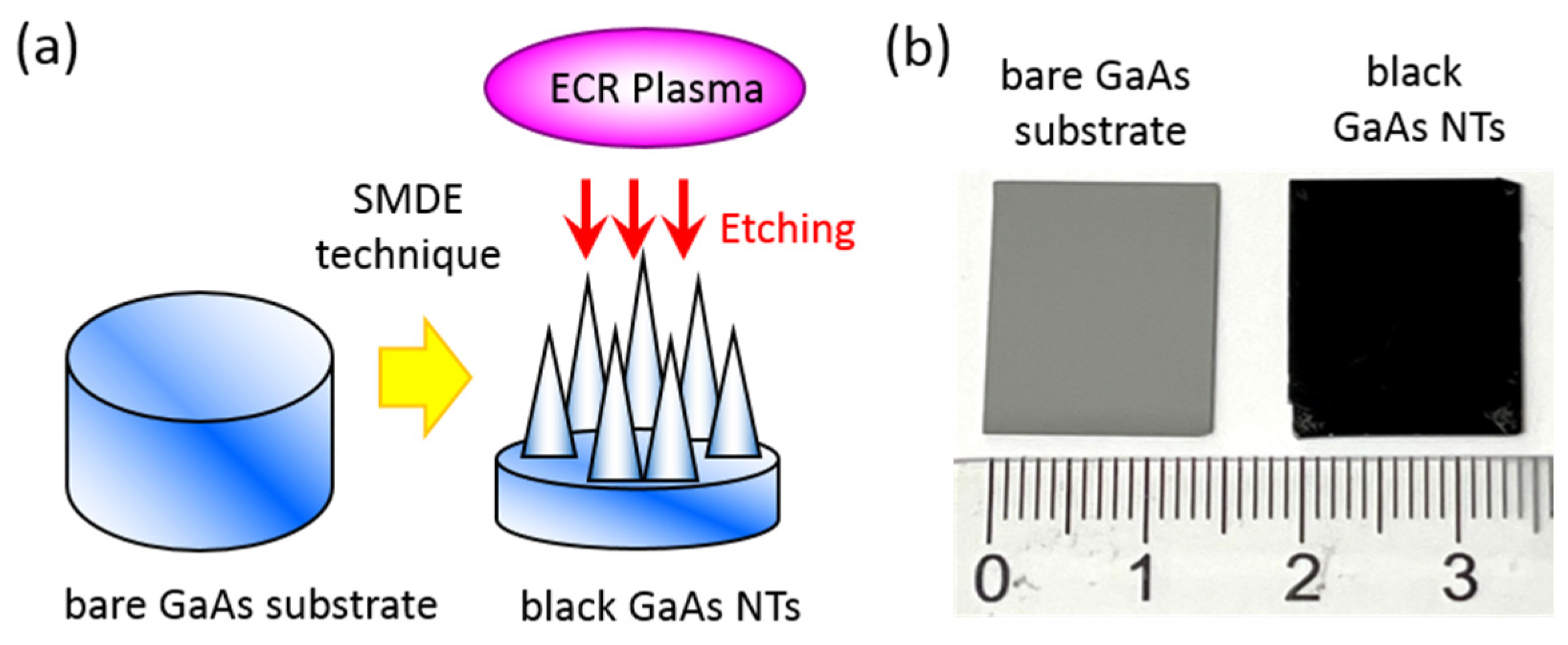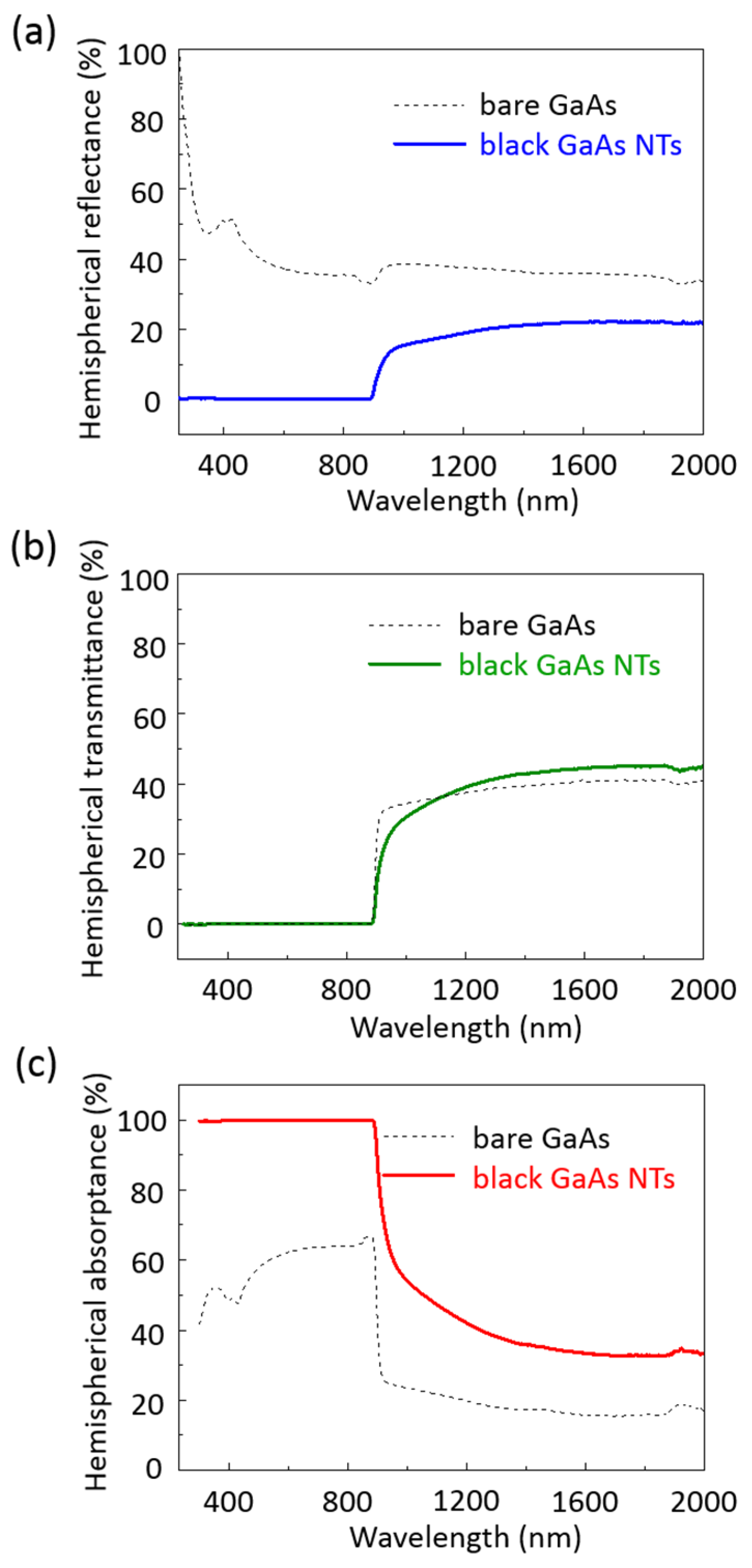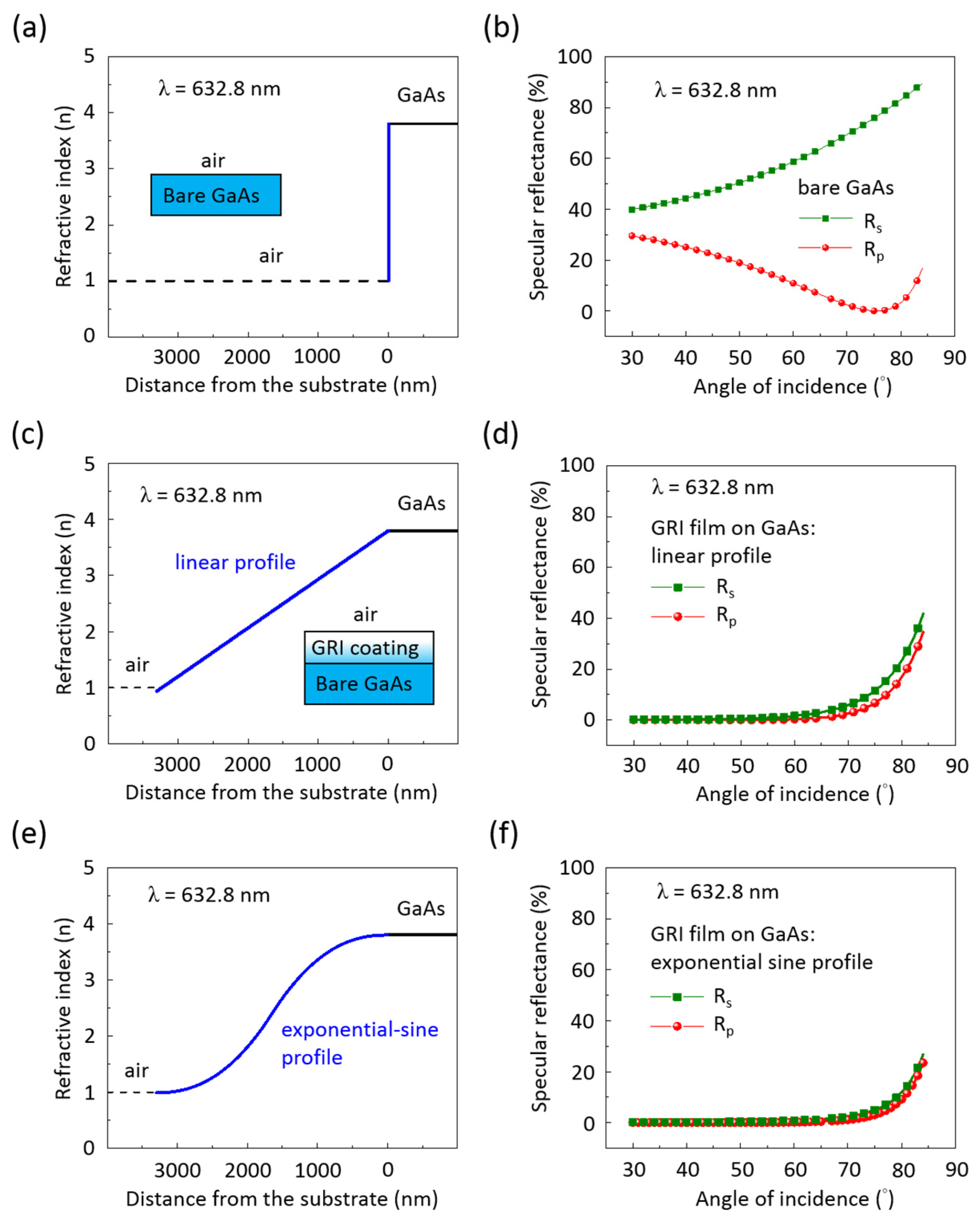Plasma-Etched Black GaAs Nanoarrays with Gradient Refractive Index Profile for Broadband, Omnidirectional, and Polarization-Independent Antireflection
Abstract
:1. Introduction
2. Materials and Methods
2.1. Sample Preparation
2.2. Material Characterization and Optical Measurements
2.3. Optical Modeling and Simulation
3. Results
3.1. Fabrication of Black GaAs NTs
3.2. Broadband Antireflection Properties
3.3. Broadband and Wide-Angle Antireflection Properties
3.4. Optical Modeling for Gradient Refractive Index Coating
3.5. Wide-Angle and Polarization-Independent Antireflection Properties
4. Discussion
5. Conclusions
Supplementary Materials
Author Contributions
Funding
Data Availability Statement
Conflicts of Interest
References
- Yoon, J.; Jo, S.; Chun, I.S.; Jung, I.; Kim, H.S.; Meitl, M.; Menard, E.; Li, X.; Coleman, J.J.; Paik, U.; et al. GaAs photovoltaics and optoelectronics using releasable multilayer epitaxial assemblies. Nature 2010, 465, 329–333. [Google Scholar] [CrossRef] [PubMed]
- Green, M.A.; Emery, K.; Hishikawa, Y.; Warta, W.; Dunlop, E.D. Solar cell efficiency tables (version 39). Prog. Photovolt. Res. Appl. 2012, 20, 12–20. [Google Scholar] [CrossRef]
- Huang, M.C.; Zhou, Y.; Chang-Hasnain, C.J. A surface-emitting laser incorporating a high-index-contrast subwavelength grating. Nat. Photonics 2007, 1, 119–122. [Google Scholar] [CrossRef]
- Dupont, E.; Liu, H.C.; Buchanan, M.; Chiu, S.; Gao, M. Efficient GaAs light-emitting diodes by photon recycling. Appl. Phys. Lett. 2000, 76, 4–6. [Google Scholar] [CrossRef]
- Tomioka, K.; Motohisa, J.; Hara, S.; Hiruma, K.; Fukui, T. GaAs/AlGaAs core multishell nanowire-based light-emitting diodes on Si. Nano Lett. 2010, 10, 1639–1644. [Google Scholar] [CrossRef] [PubMed]
- Chen, X.; Fan, Z.C.; Xu, Y.; Song, G.F.; Chen, L.H. Fabrication of biomimic GaAs subwavelength grating structures for broadband and angular-independent antireflection. Microelectron. Eng. 2011, 88, 2889–2893. [Google Scholar] [CrossRef]
- Yeo, C.I.; Kwon, J.H.; Jang, S.J.; Lee, Y.T. Antireflective disordered subwavelength structure on GaAs using spin-coated Ag ink mask. Opt. Express 2012, 20, 19554–19562. [Google Scholar] [CrossRef] [PubMed]
- Lee, Y.C.; Chang, C.C.; Chou, Y.Y. Experimental and simulation studies of anti-reflection sub-micron conical structures on a GaAs substrate. Opt. Express 2013, 21, A36–A41. [Google Scholar] [CrossRef] [PubMed]
- Lee, S.K.; Tan, C.L.; Ju, G.W.; Song, J.H.; Yeo, C.I.; Lee, Y.T. AuAg bimetallic nonalloyed nanoparticles on a periodically nanostructured GaAs substrate for enhancing light trapping. Opt. Lett. 2015, 40, 5798–5801. [Google Scholar] [CrossRef]
- Ravipati, S.; Shieh, J.; Ko, F.H.; Yu, C.C.; Chen, H.L.; Wu, C.T.; Chen, S.H. Broadband and wide angle antireflection of sub-20 nm GaAs nanograss. Energy Environ. Sci. 2012, 5, 7601–7605. [Google Scholar] [CrossRef]
- Song, Y.; Oh, J. Fabrication of three-dimensional GaAs antireflective structures by metal-assisted chemical etching. Sol. Energy Mater. 2016, 144, 159–164. [Google Scholar] [CrossRef]
- Lova, P.; Robbiano, V.; Cacialli, F.; Comoretto, D.; Soci, C. Black GaAs by metal-assisted chemical etching. ACS Appl. Mater. Interfaces 2018, 10, 33434–33440. [Google Scholar] [CrossRef]
- Wilhelm, T.S.; Kolberg, A.P.; Baboli, M.A.; Abrand, A.; Bertness, K.A.; Mohseni, P.K. Communication—Black GaAs with sub-wavelength nanostructures fabricated via lithography-free metal-assisted chemical etching. ECS J. Solid State Sci. Technol. 2019, 8, Q134–Q136. [Google Scholar] [CrossRef] [PubMed]
- Lova, P.; Soci, C. Black GaAs: Gold-assisted chemical etching for light trapping and photon recycling. Micromachines 2020, 11, 573. [Google Scholar] [CrossRef]
- Ma, J.; Zhao, Y.; Liu, W.; Song, P.; Yang, L.; Wei, J.; Yang, F.; Wang, X. Fabrication and Characterization of Black GaAs Nanoarrays via ICP Etching. Nanoscale Res. Lett. 2021, 16, 15. [Google Scholar] [CrossRef] [PubMed]
- Bao, Y.; Liu, W.; Zhao, Y.; Wei, L.; Chen, X.; Yang, F.; Wang, X. Fabrication of black GaAs by maskless inductively coupled plasma etching in Cl2/BCl3/O2/Ar chemistry. J. Vac. Sci. Technol. B 2022, 40, 022205. [Google Scholar] [CrossRef]
- Song, Y.; Choi, K.; Jun, D.H.; Oh, J. Nanostructured GaAs solar cells via metal-assisted chemical etching of emitter layers. Opt. Express 2017, 25, 23862–23872. [Google Scholar] [CrossRef]
- Behera, S.; Fry, P.W.; Francis, H.; Jin, C.Y.; Hopkinson, M. Broadband, wide-angle antireflection in GaAs through surface nano-structuring for solar cell applications. Sci. Rep. 2020, 10, 6269. [Google Scholar] [CrossRef]
- Liao, Y.; Zheng, Y.; Shin, S.H.; Zhao, Z.J.; An, S.; Seo, J.H.; Jeong, J.H.; Kim, M. Distinct UV–visible responsivity enhancement of GaAs photodetectors via monolithic integration of antireflective nanopillar structure and UV absorbing IGZO layer. Adv. Opt. Mater. 2022, 10, 2200062. [Google Scholar] [CrossRef]
- Choi, K.; Kim, K.; Moon, I.K.; Bang, J.; Oh, J. Subwavelength photocathodes via metal-assisted chemical etching of GaAs for solar hydrogen generation. Nanoscale 2019, 11, 15367–15373. [Google Scholar] [CrossRef]
- Clapham, P.B.; Hutley, M.C. Reduction of lens reflection by moth eye principle. Nature 1973, 244, 281–282. [Google Scholar] [CrossRef]
- Wilson, S.J.; Hutley, M.C. The optical properties of ‘moth eye’ antireflection surfaces. Opt. Acta 1982, 29, 993–1009. [Google Scholar] [CrossRef]
- Chattopadhyay, S.; Huang, Y.F.; Jen, Y.J.; Ganguly, A.; Chen, K.H.; Chen, L.C. Anti-reflecting and photonic nanostructures. Mater. Sci. Eng. R Rep. 2010, 69, 1–35. [Google Scholar] [CrossRef]
- Hsu, C.H.; Lo, H.C.; Chen, C.F.; Wu, C.T.; Hwang, J.S.; Das, D.; Tsai, J.; Chen, L.C.; Chen, K.H. Generally applicable self-masked dry etching technique for nanotip array fabrication. Nano Lett. 2004, 4, 471–475. [Google Scholar] [CrossRef]
- Hsu, C.H.; Huang, Y.F.; Chen, L.C.; Chattopadhyay, S.; Chen, K.H.; Lo, H.C.; Chen, C.F. Morphology control of silicon nanotips fabricated by electron cyclotron resonance plasma etching. J. Vac. Sci. Technol. B 2006, 24, 308–311. [Google Scholar] [CrossRef]
- Poitras, D.; Dobrowolski, J.A. Toward perfect antireflection coatings. 2. Theory. Appl. Opt. 2004, 43, 1286–1295. [Google Scholar] [CrossRef] [PubMed]
- Minot, M.J. The angluar reflectance of single-layer gradient refractive-index films. J. Opt. Soc. Am. 1977, 67, 1046–1050. [Google Scholar] [CrossRef]
- Southwell, W.H. Gradient-index antireflection coatings. Opt. Lett. 1983, 8, 584–586. [Google Scholar] [CrossRef]
- Verly, P.G.; Dobrowolski, J.A.; Willey, R.R. Fourier-transform method for the design of wideband antireflection coatings. Appl. Opt. 1992, 31, 3836–3846. [Google Scholar] [CrossRef]
- Dobrowolski, J.A.; Poitras, D.; Ma, P.; Vakil, H.; Acree, M. Toward perfect antireflection coatings: Numerical investigation. Appl. Opt. 2002, 41, 3075–3083. [Google Scholar] [CrossRef]
- Huang, Y.F.; Chattopadhyay, S.; Jen, Y.J.; Peng, C.Y.; Liu, T.A.; Hsu, Y.K.; Pan, C.L.; Lo, H.C.; Hsu, C.H.; Chang, Y.H.; et al. Improved broadband and quasi-omnidirectional anti-reflection properties with biomimetic silicon nanostructures. Nat. Nanotechnol. 2007, 2, 770–774. [Google Scholar] [CrossRef] [PubMed]
- Xi, J.Q.; Schubert, M.F.; Kim, J.K.; Schubert, E.F.; Chen, M.; Lin, S.Y.; Liu, W.; Smart, J.A. Optical thin-film materials with low refractive index for broadband elimination of Fresnel reflection. Nat. Photonics 2007, 1, 176–179. [Google Scholar] [CrossRef]
- Chen, J.; Wang, B.; Yang, Y.; Shi, Y.; Xu, G.; Cui, P. Porous anodic alumina with low refractive index for broadband graded-index antireflection coatings. Appl. Opt. 2012, 51, 6839–6843. [Google Scholar] [CrossRef] [PubMed]
- Kauppinen, C.; Isakov, K.; Sopanen, M. Grass-like alumina with low refractive index for scalable, broadband, omnidirectional antireflection coatings on glass using atomic layer deposition. ACS Appl. Mater. Interfaces 2017, 9, 15038–15043. [Google Scholar] [CrossRef]
- Leem, J.W.; Yu, J.S. Multi-functional antireflective surface-relief structures based on nanoscale porous germanium with graded refractive index profiles. Nanoscale 2013, 5, 2520–2526. [Google Scholar] [CrossRef]
- Tompkins, H.G. A User’s Guide to Ellipsometry; Academic Press: New York, NY, USA, 1999. [Google Scholar]






Disclaimer/Publisher’s Note: The statements, opinions and data contained in all publications are solely those of the individual author(s) and contributor(s) and not of MDPI and/or the editor(s). MDPI and/or the editor(s) disclaim responsibility for any injury to people or property resulting from any ideas, methods, instructions or products referred to in the content. |
© 2024 by the authors. Licensee MDPI, Basel, Switzerland. This article is an open access article distributed under the terms and conditions of the Creative Commons Attribution (CC BY) license (https://creativecommons.org/licenses/by/4.0/).
Share and Cite
Huang, Y.-F.; Jen, Y.-J.; Modak, V.A.; Chen, L.-C.; Chen, K.-H. Plasma-Etched Black GaAs Nanoarrays with Gradient Refractive Index Profile for Broadband, Omnidirectional, and Polarization-Independent Antireflection. Nanomaterials 2024, 14, 1154. https://doi.org/10.3390/nano14131154
Huang Y-F, Jen Y-J, Modak VA, Chen L-C, Chen K-H. Plasma-Etched Black GaAs Nanoarrays with Gradient Refractive Index Profile for Broadband, Omnidirectional, and Polarization-Independent Antireflection. Nanomaterials. 2024; 14(13):1154. https://doi.org/10.3390/nano14131154
Chicago/Turabian StyleHuang, Yi-Fan, Yi-Jun Jen, Varad A. Modak, Li-Chyong Chen, and Kuei-Hsien Chen. 2024. "Plasma-Etched Black GaAs Nanoarrays with Gradient Refractive Index Profile for Broadband, Omnidirectional, and Polarization-Independent Antireflection" Nanomaterials 14, no. 13: 1154. https://doi.org/10.3390/nano14131154






